
Rajasthan is a state in northwestern India. It covers 342,239 square kilometres (132,139 sq mi) or 10.4 per cent of India's total geographical area. It is the largest Indian state by area and the seventh largest by population. It is on India's northwestern side, where it comprises most of the wide and inhospitable Thar Desert and shares a border with the Pakistani provinces of Punjab to the northwest and Sindh to the west, along the Sutlej-Indus River valley. It is bordered by five other Indian states: Punjab to the north; Haryana and Uttar Pradesh to the northeast; Madhya Pradesh to the southeast; and Gujarat to the southwest. Its geographical location is 23°.3' to 30°.12' North latitude and 69°.30' to 78°.17' East longitude, with the Tropic of Cancer passing through its southernmost tip.

Jaipur is the capital and the largest city of the north-western Indian state of Rajasthan. As of 2011, the city has a population of 3.1 million, making it the tenth most populous city in the country. Located 268 km from the national capital New Delhi, Jaipur is also known as the Pink City due to the dominant color scheme of its buildings in old city.
Tourism in India is 4.6% of the country's gross domestic product (GDP). Unlike other sectors, tourism is not a priority sector for the Government of India. The World Travel and Tourism Council calculated that tourism generated ₹13.2 lakh crore (US$150 billion) or 5.8% of India's GDP and supported 32.1 million jobs in 2021. Even though, these numbers were lower than the pre-pandemic figures; the country's economy witnessed a significant growth in 2021 after the massive downturn during 2020. The sector is predicted to grow at an annual rate of 7.8% to ₹33.8 lakh crore (US$400 billion) by 2031. India has established itself as the 5th largest global travel healthcare destination with an estimated market size of around $9 billion in 2019, out of the total global travel healthcare industry of $44.8 billion(2019). In 2014, 184,298 foreign patients travelled to India to seek medical treatment.
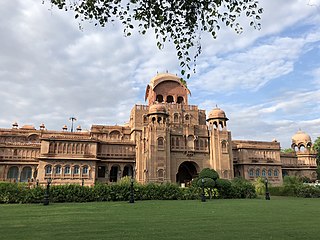
Bikaner is a city in the northwest of the state of Rajasthan, India. It is located 330 kilometres (205 mi) northwest of the state capital, Jaipur. It is the administrative headquarters of Bikaner District and Bikaner division.

The Surin Elephant Round-up is a cultural festival held every year in Surin Province, Isan, Thailand. Usually the event is organized during the third week of November on the weekend. The festival has its origins in the royal hunts which were conducted in Surin Province during medieval times. The indigenous residents of Surin, the Kuy, have been traditional practitioners of corralling elephants and training them as working animals. When the Ayutthaya Kingdom came into power these hunts were converted into a public extravaganza and wild elephants were replaced with tame ones. The festival, in its contemporary form, was first organized in the 1960s when civil war in Cambodia and the steady decline in economic value of elephants forced the elephant handlers (mahouts) to seek occupations in the entertainment and tourism industry.

The Pushkar Fair, also called the Pushkar Camel Fair or locally as Kartik Mela or Pushkar ka Mela is an annual multi-day livestock fair and cultural fête held in the town of Pushkar near Ajmer city in Ajmer district in. The fair starts with the Hindu calendar month of Kartik and ends on the Kartik Purnima, which typically overlaps with late October and early November in the Gregorian calendar. In 1998, over 1 million visitors came to Pushkar throughout the year. The Pushkar fair alone attracts over 200,000 visitors.
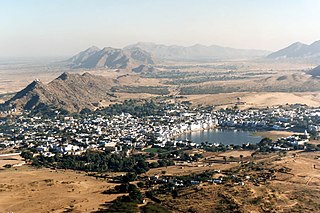
Pushkar is a temple town near Ajmer City and headquarters of Pushkar tehsil in the Ajmer district in the Indian state of Rajasthan. It is situated about 10 km (6.2 mi) northwest of Ajmer and about 150 kilometres (93 mi) southwest of Jaipur. It is a pilgrimage site for Hindus and Sikhs. Pushkar has many temples. Most of the temples and ghats in Pushkar are from the 18th century and later, because many temples were destroyed during Muslim conquests in the area. Subsequently, the destroyed temples were rebuilt. The most famous among Pushkar temples is the red spired Brahma Temple. It is considered a sacred city by the Hindus particularly in Shaktism, and meat and eggs consumption are forbidden in the city as are alcohol and drugs. Pushkar is located on the shore of Pushkar Lake, which has many ghats where pilgrims bathe. Pushkar is also significant for its Gurdwaras for Guru Nanak and Guru Gobind Singh. One of the bathing ghats is called Gobind ghat built by the Sikhs in the memory of Guru Gobind Singh.

Jhalawar ( ) is a city, municipal council and headquarter in Jhalawar district of the Indian state of Rajasthan. It is located in the southeastern part of the state. It was the capital of the former princely state of Jhalawar, and is the administrative Jhalawar district. Its district headquarters is Jhalawar. This district is the 22nd largest district of Rajasthan. This district is known by the nicknames of Cherrapunji of Rajasthan, Nagpur of Rajasthan, Brijnagar of Rajasthan etc. Cherrapunji of rajasthan because the highest rainfall in the whole of Rajasthan occurs in manoharthana town in this district. Gagron fort at the confluence of Kalisindh and Ahu river at some distance from Jhalawar It is situated which is one of the Jaldurg of Rajasthan and it is such a fort which is a standing fort without foundation. This fort was included in the UNESCO World Heritage List in 2013.

Pushkar Lake or Pushkar Sarovar is located in the town of Pushkar near Ajmer city in Ajmer district of the Rajasthan state of western India. Pushkar Lake is a sacred lake of the Hindus. The Hindu scriptures describe it as "Tirtha-Guru" [Thirtha Raj]– the perceptor of pilgrimage sites related to a water-body and relate it to the mythology of the creator-god Brahma, whose most prominent temple stands in Pushkar. The Pushkar Lake finds mention on coins as early as the 4th century BC.
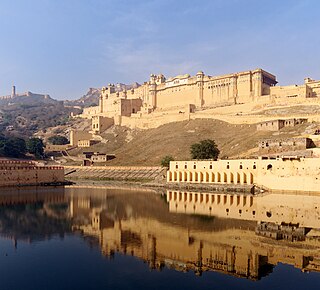
Amer Fort or Amber Fort is a fort located in Amer, Rajasthan, India. Amer is a town with an area of 4 square kilometres (1.5 sq mi) located 11 kilometres (6.8 mi) from Jaipur, the capital of Rajasthan. Located high on a hill, it is the principal tourist attraction in Jaipur. Amer Fort is known for its artistic style elements. With its large ramparts and series of gates and cobbled paths, the fort overlooks Maota Lake, which is the main source of water for the Amer Palace.
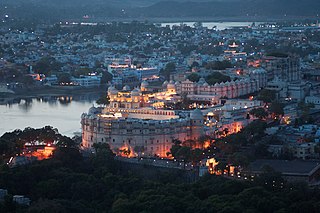
Udaipur is a city in the north-western Indian state of Rajasthan, about 415 km (258 mi) south of the state capital Jaipur. It serves as the administrative headquarters of Udaipur district. It is the historic capital of the kingdom of Mewar in the former Rajputana Agency. It was founded in 1559 by Udai Singh II of the Sisodia clan of Rajputs, when he shifted his capital from the city of Chittorgarh to Udaipur after Chittorgarh was besieged by Akbar. It remained as the capital city till 1818 when Mewar became a British princely state, and thereafter the Mewar province became a part of Rajasthan when India gained independence in 1947. It is also known as the City of Lakes, as it is surrounded by five major artificial lakes.

Mysore Dasara is the state festival in the state of Karnataka in India. It is a 10-day festival, starting with nine nights called Navaratri and the last day being Vijayadashami. The festival is observed on the tenth day in the Hindu calendar month of Ashvina, which typically falls in the Gregorian months of September and October.
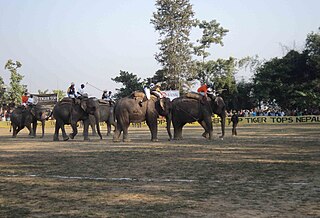
Elephant polo is a variant of polo played while riding elephants. It is played in Nepal, and Thailand. England and Scotland regularly field teams. Equipment consists of a standard polo ball and a 1.8 metres (5.9 ft) to 3 metres (9.8 ft) cane sticks with a polo mallet head on the end. The pitch is three-quarters of the length of a standard polo pitch, due to the lower speed of the elephants. Two people ride each elephant; the elephants are steered by mahouts, while the player tells the mahout which way to go and hits the ball.
The Jaipur Literature Festival, or JLF, is an annual literary festival which takes place in the Indian city of Jaipur each year in the month of January. It was founded in 2006.

Rajasthan is one of the most popular tourist destinations in India, for both domestic and international tourists. Rajasthan attracts tourists for its historical forts, palaces, art and culture with its slogan "Padharo Mhare Desh ". The capital city, Jaipur, also known as Pink City, is a very popular tourist destination place and it is a part of the Golden Triangle. The Walled City of Jaipur is only the second Indian city to be recognized as a UNESCO World Heritage Site, after Ahmedabad.

The India Tourism Development Corporation (ITDC) is a hospitality, retail and education company owned by the Government of India, under the administration of the Ministry of Tourism. Established in 1966, it owns over 17 properties under the Ashok Group of Hotels brand, across India.
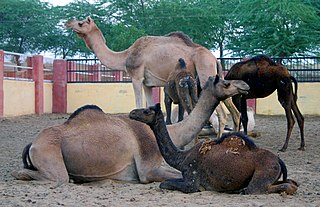
ICAR-National Research Centre on Camel, Bikaner, is a Premier Research Centre located at Bikaner city of Rajasthan. Considering the importance of camel in the socio-economic development of arid and semi-arid zones, the Government of India established a Project Directorate on Camel at Bikaner (India) on 5 July 1984 under aegis of Indian Council of Agricultural Research (ICAR) which was upgraded to National Research Centre on Camel (NRCC) on 20 September 1995. It is located in the Jorbeer area of Bikaner city which is about 8 km from Bikaner main city. Mandates of this institute are 1. Basic and applied research for improvement camel health and production; 2. Information repository on camel research and development; and 3. Development of camel eco-tourism. This centre is also known as 'Camel Farm' among the local people. The camel farm maintains an elite herd of more than 300 camels of Bikaneri, Jaisalmeri, Kachchhi and Mewari breeds.

The Ajmer Jain temple, also known as Soniji Ki Nasiyan, is a Jain temple known for its architecture. It was built in the late nineteenth century. The main chamber, known as the Swarna Nagari "City of Gold", has several gold-plated wooden figures, depicting several figures in the Jain religion. This golden chamber of the temple uses 1,000 kg of gold to carve out a depiction of Ayodhya.

Suparna Baksi Ganguly is an Indian activist concerned with the treatment of animals and in particular elephants that are held captive. She was given the highest award for women in India, the Nari Shakti Puraskar in 2016.

Bundi Utsav, or Bundi Festival, is an annual cultural and tourism festival celebrated in the city of Bundi, located in the Hadoti region of Rajasthan, India. This vibrant festival showcases the rich cultural heritage, traditional art forms, and historical significance of Bundi. It typically takes place in the month of November and spans over three days, attracting both domestic and international tourists.

















